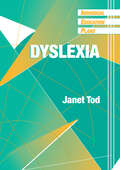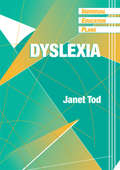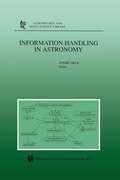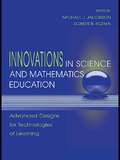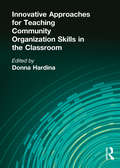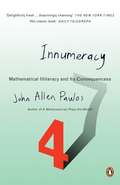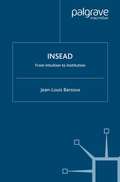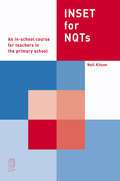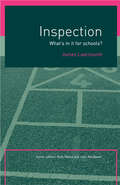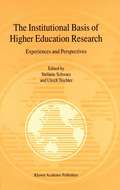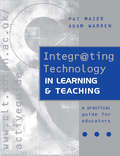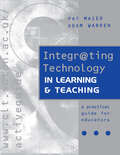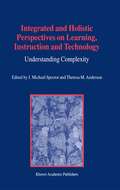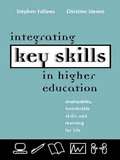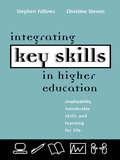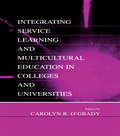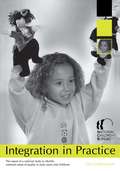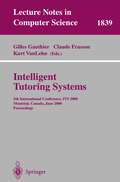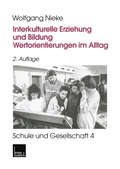- Table View
- List View
Individual Education Plans: Dyslexia (Ieps Ser.)
by Janet Tod Mike Blamires Francis CastleFirst Published in 2000. Routledge is an imprint of Taylor & Francis, an informa company.
Individual Education Plans (IEPs): Dyslexia
by Janet Tod Mike Blamires Francis CastleFirst Published in 2000. Routledge is an imprint of Taylor & Francis, an informa company.
Information Handling in Astronomy (Astrophysics and Space Science Library #250)
by Andre HeckThe pilot boat just moved away and'its lights are already fading towards the coast of Northeastern Queensland over which Saturn is going to set. There is still quite some time to go before dawn. The big ship has now regained her cruise speed following its roughly northwesterly route in the South Coral Sea along the chain of nearby reefs. Few people are around at this time, except a dozen early birds sharing some 'shipshaping' exercise on the top deck and taking advantage of the relative coolness of the night. On my way down to the stateroom, I cannot but stop once more in front of that elegant composition by British artist Brigid Collins (1963-) hanging in the monumental staircase between Decks 7 and 8. That piece 2 of art, a 1.8x 1.8m oil on canvas plus collage entitled Berinl in honour of the Danish explorer, gathers together many navigation-related themes of the time: Suns, Moons, planets, sky maps, astrolabes, small telescopes, as well as drawings, diagrams and charts of all kinds. It is somehow a digest of how astronomical information was then collected, made available, and used.
Innovations in Science and Mathematics Education: Advanced Designs for Technologies of Learning
by Michael J. Jacobson Robert B. KozmaThe uses of technology in education have kindled great interest in recent years. Currently, considerable resources are being expended to connect schools to the Internet, to purchase powerful (and increasingly affordable) computers, and on other implementations of educational technologies. However, the mere availability of powerful, globally-connected computers is not sufficient to insure that students will learn--particularly in subjects that pose considerable conceptual difficulties, such as in science and mathematics. The true challenge is not just to put the newest technologies in our schools, but to identify advanced ways to design and use these new technologies to advance learning. This book offers a "snapshot" of current work that is attempting to address this challenge. It provides valuable and timely information to science and mathematics educators, educational and cognitive researchers, instructional technologists and educational software developers, educational policymakers, and to scholars and students in these fields.
Innovations in Science and Mathematics Education: Advanced Designs for Technologies of Learning
by Michael J. Jacobson Robert B. KozmaThe uses of technology in education have kindled great interest in recent years. Currently, considerable resources are being expended to connect schools to the Internet, to purchase powerful (and increasingly affordable) computers, and on other implementations of educational technologies. However, the mere availability of powerful, globally-connected computers is not sufficient to insure that students will learn--particularly in subjects that pose considerable conceptual difficulties, such as in science and mathematics. The true challenge is not just to put the newest technologies in our schools, but to identify advanced ways to design and use these new technologies to advance learning. This book offers a "snapshot" of current work that is attempting to address this challenge. It provides valuable and timely information to science and mathematics educators, educational and cognitive researchers, instructional technologists and educational software developers, educational policymakers, and to scholars and students in these fields.
Innovative Approaches for Teaching Community Organization Skills in the Classroom
by Donna HardinaBring your students the latest developments in community organization!Innovative Approaches for Teaching Community Organization Skills in the Classroom will help social work educators efficiently teach students methods of practice that they need to know in order to offer the best services to clients with a variety of different needs in a variety of settings. Here you'll find assignments and exercises that combine new technology with progressive ideas about integrating theory and practice. This valuable book consistently addresses topics that will stimulate discussion on the value assumptions inherent in community practice, appropriate ways to transmit these values in the classroom, and the best way to help students develop their own frameworks for ethical decisionmaking.Innovative Approaches for Teaching Community Organization Skills in the Classroom will be a valuable addition to your collection. This accessible and comprehensive book identifies and provides detailed information for teaching these skills in the classroom: ethical decisionmaking community assessment interpersonal skills development making your practice effective in a multi-cultural environment organizing your practice with computer technologyThis book describes teaching methods that will educate your students on the development of self-awareness, multicultural competency, and ethical content for practice, preparing them for the diverse situations that may arise in their professional careers.
Innovative Approaches for Teaching Community Organization Skills in the Classroom
by Donna HardinaBring your students the latest developments in community organization!Innovative Approaches for Teaching Community Organization Skills in the Classroom will help social work educators efficiently teach students methods of practice that they need to know in order to offer the best services to clients with a variety of different needs in a variety of settings. Here you'll find assignments and exercises that combine new technology with progressive ideas about integrating theory and practice. This valuable book consistently addresses topics that will stimulate discussion on the value assumptions inherent in community practice, appropriate ways to transmit these values in the classroom, and the best way to help students develop their own frameworks for ethical decisionmaking.Innovative Approaches for Teaching Community Organization Skills in the Classroom will be a valuable addition to your collection. This accessible and comprehensive book identifies and provides detailed information for teaching these skills in the classroom: ethical decisionmaking community assessment interpersonal skills development making your practice effective in a multi-cultural environment organizing your practice with computer technologyThis book describes teaching methods that will educate your students on the development of self-awareness, multicultural competency, and ethical content for practice, preparing them for the diverse situations that may arise in their professional careers.
Innumeracy: Mathematical Illiteracy and Its Consequences
by John Allen PaulosWhy do even well-educated people often understand so little about maths - or take a perverse pride in not being a 'numbers person'?In his now-classic book Innumeracy, John Allen Paulos answers questions such as: Why is following the stock market exactly like flipping a coin? How big is a trillion? How fast does human hair grow in mph? Can you calculate the chances that a party includes two people who have the same birthday? Paulos shows us that by arming yourself with some simple maths, you don't have to let numbers get the better of you.
Insead: From Intuition to Institution
by J. BarsouxIn 2000 INSEAD celebrates its forthieth anniversary. In this time INSEAD has grown to be the leading business and management school in Europe, and one of the most successful and influential in the world. This book is a business study and history of INSEAD which details how this success was achieved, and goes on to relate the story of the school to the management themes of leadership, teamworking and innovation. Available in English and French editions.
INSET For NQTs: An In-school Course for Teachers in the Primary School
by Neil KitsonAn independent-study workbook designed for newly qualified teachers (NQTs). This text will lead the teacher through a range of activities which have been designed to help them to get to know and understand all the important school systems, the children and themselves as teachers. The materials can be used throughout the first and/or second years of teaching.
INSET For NQTs: An In-school Course for Teachers in the Primary School
by Neil KitsonAn independent-study workbook designed for newly qualified teachers (NQTs). This text will lead the teacher through a range of activities which have been designed to help them to get to know and understand all the important school systems, the children and themselves as teachers. The materials can be used throughout the first and/or second years of teaching.
Inspection: What's In It for Schools? (What's in it for schools?)
by James LearmonthThis text traces the development of different forms of inspection. It draws on a range of sources such as rigorous and informed research and inspection evidence, writing by key figures, teachers' own experiences, newspaper headlines and other comments, whilst remaining jargon-free. This topical book includes summary questions and other signposts for the reader, as well as a fully annotated bibliography. It also pays attention to other types of school self-evaluation.James Learmouth explores the impact of inspection on schools in difficulties, and outlines the ways in which research and other evidence suggests that schools do improve.
Inspection: What's In It for Schools? (What's in it for schools?)
by James LearmonthThis text traces the development of different forms of inspection. It draws on a range of sources such as rigorous and informed research and inspection evidence, writing by key figures, teachers' own experiences, newspaper headlines and other comments, whilst remaining jargon-free. This topical book includes summary questions and other signposts for the reader, as well as a fully annotated bibliography. It also pays attention to other types of school self-evaluation.James Learmouth explores the impact of inspection on schools in difficulties, and outlines the ways in which research and other evidence suggests that schools do improve.
The Institutional Basis of Higher Education Research: Experiences and Perspectives
by UlrichTeichler StefanieSchwarzIn the US, the university administration runs its own office of “insti- tional research” in order to base its decisions on systematic information. Furthermore, higher education research can rely on a relatively stable academic basis if study programmes on higher education exist. Again, this is most frequently the case in the United States. Finally, governments and other macro-societal actors sometimes have their own offices or institutes of policy research and prepare the policies of the actors they report to. In addition, research on higher education can be institutionalized in a - riety of ways. Often, research institutes on higher education are quite visible. They were established as specialized research units within or outside insti- tions of higher education; but no common institutional basis can be observed for this type of institution across the countries. Third, the major themes of research on higher education also differ - tween countries. It has frequently been said that in European countries it was more prone to analyse macro-societal issues of higher education, whereas in the US it tended to study the inner life of higher education institutions, s- dents, and the teaching and learning processes.
Integr@ting Technology in Learning and Teaching
by Maier, Pat Warren, Adam (both of the Interactive Learning Centre, Southampton University)This volume looks at the issues involved in integrating new technologies within the education process. It includes activities, case studies and notes for use by all teaching in higher education.
Integr@ting Technology in Learning and Teaching: A Practical Guide For Educators
by Maier, Pat Warren, Adam (both of the Interactive Learning Centre, Southampton University)This volume looks at the issues involved in integrating new technologies within the education process. It includes activities, case studies and notes for use by all teaching in higher education.
Integrated and Holistic Perspectives on Learning, Instruction and Technology: Understanding Complexity
by J. Michael Spector Theresa M. AndersonOne outcome of recent progress in educational technology is strong interest in providing effective support for learning in complex and ill-structured domains. We know how to use technology to promote understanding in simpler domains (e.g., orientation information, procedures with minimal-branching, etc.), but we are less sure how to use technology to support understanding in more complex domains (e.g., managing limited resources, understanding environmental impacts, etc.). Such domains are increasingly significant for society. Technology (e.g., collaborative tele-learning, digital repositories, interactive simulations, etc.) can provide conceptually and functionally rich domains for learning. However, this introduces the problem of determining what works in which circumstances and why. Research and development on these matters is reflected in this collection of papers. This research suggests a need to rethink foundational issues in educational philosophy and learning technology. One major theme connecting these papers is the need to address learning in the large - from a more holistic perspective. A second theme concerns the need to take learners where and as they are, integrating technology into effective learning places. Significant and systematic progress in learning support for complex domains demands further attention to these important issues.
Integrating Key Skills In Higher Education: Employability, Transferable Skills And Learning For Life (PDF)
by Stephen Fallows Christine Stevens Christine StevenThis text addresses both the issues and practicalities of key skills in higher education. It discusses the issues relating to the introduction of key skills, drawing on both the arguments and theory of why key skills should (or should not) be introduced. Case study material is included.
Integrating Key Skills in Higher Education: Employability, Transferable Skills and Learning for Life
by Stephen Fallows Christine StevenThis text addresses both the issues and practicalities of key skills in higher education. It discusses the issues relating to the introduction of key skills, drawing on both the arguments and theory of why key skills should (or should not) be introduced. Case study material is included.
Integrating Key Skills in Higher Education: Employability, Transferable Skills and Learning for Life
by Stephen Fallows Christine StevenThis text addresses both the issues and practicalities of key skills in higher education. It discusses the issues relating to the introduction of key skills, drawing on both the arguments and theory of why key skills should (or should not) be introduced. Case study material is included.
Integrating Service Learning and Multicultural Education in Colleges and Universities
by Carolyn R. O'GradyThe focus of this book is on the ways in which service learning and multicultural education can and should be integrated so that each may be strengthened and consequently have greater effect on educational and social conditions. It offers a significant attempt to forge a dialogue among practitioners of service learning and multicultural education. The overriding theme is that service learning without a focused attention to the complexity of racial and cultural differences can reinforce the dominant cultural ideology, but academic work that seeks to deconstruct these norms without providing a community-based touchstone isolates students and schools from the realities of the larger communities of which they are part. Although the chapter authors provide varied perspectives on the benefits and challenges of integrating multicultural education and service learning, they all are committed to a vision of education that synthesizes both action and reflection. None of the authors pretend to have all the answers to what this integration should look like, nor do they believe that today's social problems are easily ameliorated through education. Rather, they share theories, practices, failures, and triumphs in order to further the conversation about the importance of aligning what educators say about the world and how they act in and on it. These authors share the view that multicultural education is truly transformative for students only when it includes a community action component, and likewise, service learning is truly a catalyst for change only when it is done from a multicultural and socially just perspective. It is their hope that the ideas explored in this book will further the work of those who share a commitment to the integration of action and reflection.
Integrating Service Learning and Multicultural Education in Colleges and Universities
by Carolyn R. O’GradyThe focus of this book is on the ways in which service learning and multicultural education can and should be integrated so that each may be strengthened and consequently have greater effect on educational and social conditions. It offers a significant attempt to forge a dialogue among practitioners of service learning and multicultural education. The overriding theme is that service learning without a focused attention to the complexity of racial and cultural differences can reinforce the dominant cultural ideology, but academic work that seeks to deconstruct these norms without providing a community-based touchstone isolates students and schools from the realities of the larger communities of which they are part. Although the chapter authors provide varied perspectives on the benefits and challenges of integrating multicultural education and service learning, they all are committed to a vision of education that synthesizes both action and reflection. None of the authors pretend to have all the answers to what this integration should look like, nor do they believe that today's social problems are easily ameliorated through education. Rather, they share theories, practices, failures, and triumphs in order to further the conversation about the importance of aligning what educators say about the world and how they act in and on it. These authors share the view that multicultural education is truly transformative for students only when it includes a community action component, and likewise, service learning is truly a catalyst for change only when it is done from a multicultural and socially just perspective. It is their hope that the ideas explored in this book will further the work of those who share a commitment to the integration of action and reflection.
Integration in Practice: The report of a national study to identify common areas of quality in early years and childcare (PDF)
by Ann Jamieson Claire Cordeaux Lucy WilkinsonThis report comes from a study to identify and audit materials used as a basis for integrated practice to support the learning of children from 0-14 years of age. A working list of 69 common quality areas emerged from the national and local audits. Organised under eight principles: community partnership, documentation, equal opportunities, learning and teaching, developing citizenship, environment, health and well-being, staffing and professional development, the 69 common quality areas are explained and illustrated with examples.
Intelligent Tutoring Systems: 5th International Conference, ITS 2000, Montreal, Canada, June 19-23, 2000 Proceedings (Lecture Notes in Computer Science #1839)
by Gilles Gauthier Claude Frasson Kurt VanLehnITS 2000 is the fifth international conference on Intelligent Tutoring Systems. The preceding conferences were organized in Montreal in 1988, 1992, and 1996. These conferences were so strongly supported by the international community that it was decided to hold them every two years. ITS’98 was organized by Carol Redfield and Valerie Shute and held in San Antonio, Texas. The program committee included members from 13 countries. They received 140 papers (110 full papers and 30 young researchers papers) from 21 countries. As with any international conference whose proceedings serve as a reference for the field, the program committee faced the demanding task of selecting papers from a particularly high quality set of submissions. This proceedings volume contains 61 papers selected by the program committee from the 110 papers submitted. They were presented at the conference, along with six invited lectures from well known speakers. The papers cover a wide range of subjects including architectures for ITS, teaching and learning strategies, authoring systems, learning environments, instructional designs, cognitive approaches, student modeling, distributed learning environments, evaluation of instructional systems, cooperative systems, Web based training systems, intelligent agents, agent based tutoring systems, intelligent multimedia and hypermedia systems, interface design, and intelligent distance learning.
Interkulturelle Erziehung und Bildung: Wertorientierungen im Alltag (Schule und Gesellschaft #4)
by Wolfgang Nieke"Wir wenden uns vor allem an die Lehrer . . . und wollen ihnen die Mittel für die neue Arbeit bereitstellen, darüber hinaus aber alle Menschen sammeln, die guten Willens sind und der gewaltlosen Macht des Geistes vertrauen. " (Herman Nohl 1 1945 ) Aus der Fülle der inzwischen unter der Bezeichnung Interkulturelle Erziehung diskutierten pädagogisch praktischen und theoretischen Probleme soll hier eine zentrale Fragestellung herausgehoben und zu einer möglichen Lösung gebracht werden: Wie kann zu einem verantwortlichen und vernünftigen Umgang der Angehörigen von Mehrheit und Minderheiten in einer Gesellschaft angeleitet werden? Diese Frage hat zwei Dimensionen: - eine auf die Ungleichheit der Macht zwischen Mehrheit und Minderheiten bezogene - und eine zweite auf die Differenz der Selbst- und Fremddefinitionen bezogene, mit denen sich Mehrheit und Minderheiten jeweils selbst und in Abgrenzung dazu die jeweils anderen bestimmen und identifizieren. Diese beiden Dimensionen trennen nur analytisch, faktisch hängen Macht und Definition von Unterschieden sehr eng miteinander zusammen. Für eine genaue gedankliche Aufschließung der dahinter liegenden Problematik ist es jedoch zulässig, analytisch eine Weile nur der einen Dimension zu folgen und die andere unerörtert im Hintergrund stchen zu lassen. Die Sclbst- und Fremddefinitionen von Mehrheit und Minderheiten in einer Gesellschaft setzen oft - und für den hier interessierenden Fall von ethnischen Minderheiten, vor allem solche von Zuwanderern in Deutschland - fast ausschließlich an Besonderheiten an, zu deren Bezeichnung der Begriff der Kultur verwendet wird.
